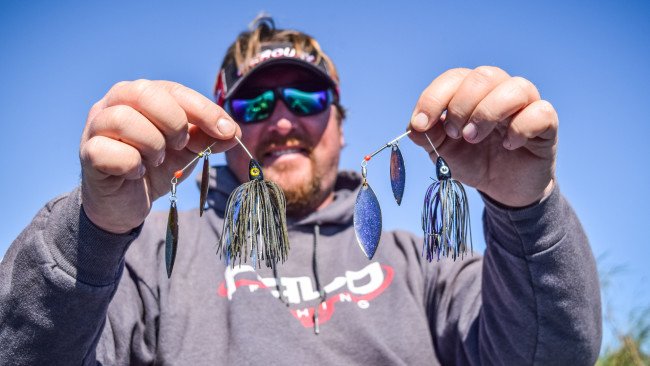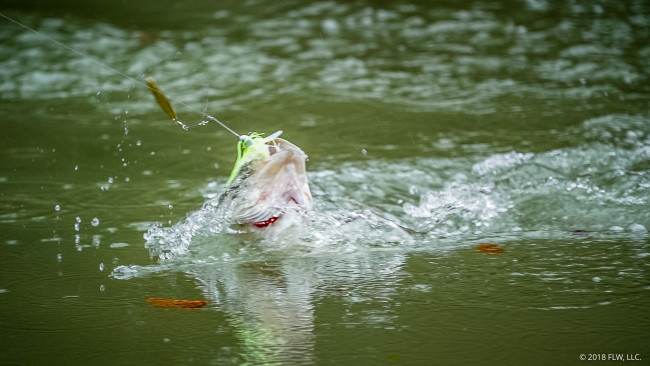Painted Blades on Spinnerbaits
The right amount of flash and accent color can make a big difference in your blade bite

A bright chartreuse skirt and fluorescent orange blade – the details of Jeff Sprague’s spinnerbait weren’t hard to distinguish each time he whipped it into the muddy shallows in the upper end of one of Grand Lake’s biggest creeks. That was sort of the point of the gaudy combination; not to make it visible to the spectators watching Sprague contend for the win at the Costa FLW Series Southwestern Division event, but to make it more visible to the bass living in the stained water.
While nickel and gold blades have been and always will be the standard choices on spinnerbaits, using painted blades is a good way to dial in the bite for a variety of conditions – the way Sprague did in Grand’s shallow, muddy waters. Paint also expands the options for spinnerbait components to give anglers even more thousands of combinations to tackle just about any situation.
Matching forage, countering clarity
According to most pros, the two primary reasons for choosing a painted blade are to match a local forage fish and to counter varying degrees of water clarity and sunlight penetration.
Matching forage fish might mean using dark-colored blades or blades with some chartreuse when bass are eating bluegills, or choosing silver and white blades when they’re eating shad.
The water clarity/sunlight issue is more complex.
Sediment in dirty water blocks the sunlight from penetrating very far, which can prevent a metallic blade from reflecting light in the same way as in clear water. That’s when many pros will accent with a painted blade to create a better visual target. In contrast, sometimes the goal is to mute the reflection of the metallic blades, and a matte or transparent color coating effectively dulls it down.
There are also times when a colored blade just works better because, like a lot of situations in fishing, that’s just what the bass will bite that day, and there’s no real explanation for why.
What follows are some of the more common color combinations and strategies for fishing them used by FLW pros. This list is far from complete because there are nearly endless combinations of skirt and blade colors and blade style configurations. This just gives you some idea of what the top pros have already proved will work.
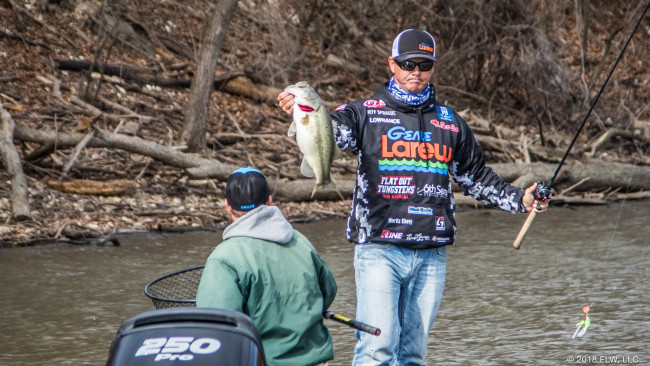
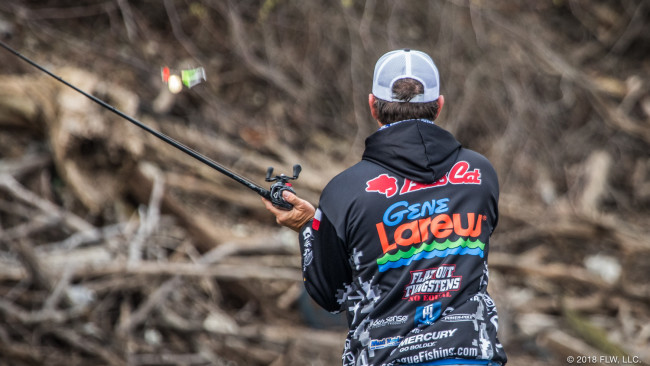
Red and orange Colorado blades
Painted blade preferences are regional based on water clarity, forage and other factors. In the Southern Plains and Ozark regions, some of the most common configurations include a red or orange Colorado blade on a single-Colorado spinnerbait, double-Colorado spinnerbait or willow/Colorado spinnerbait.
According to Sprague, that particular combo of color and heavy thump from the Colorado is great in the spring.
“Painted blades usually work in a small window early in the spring when the water is in the 50s,” Sprague says. “A lot of times when we throw those blades we do it because of water clarity. In early spring we get a lot of rain, and the water is really dirty or murky. Along with the vibration that particular type of blade creates, that’s just another way for a bass to locate a bait because they can actually see it in that murkier water.”
Sprague also believes that bass key on particular colors in the spring – primarily red and white, or bright shades that stand out well – because of their behavior patterns.
“That time of year when bass are really aggressive, I think a color can trigger a strike, or at least make them commit to a strike,” Sprague adds.
Dark Colorado blades
Purple and black are popular blade colors for big single-Colorado spinnerbaits that are commonly used for night-fishing because they combine with a dark skirt to create a big profile fish can make out in moonlit conditions. Sprague says he’ll also throw a dark purple blade in muddy water and will match it with a dark skirt.
“I throw a lot of junebug-colored skirts in the early spring, too,” he says. “I’ll throw a purple blade with a gold blade on a darker-colored skirt – anything from black to junebug or brown – to represent bream.”
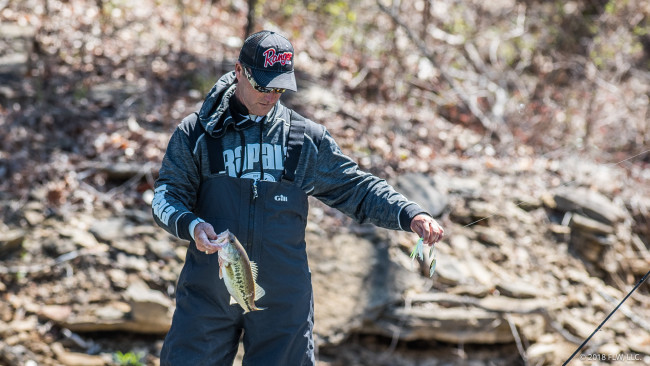
Chartreuse and white willow blades
There are many applications for painted willow blades. While they come in all colors, white, chartreuse and white with additional accent colors are most popular.
FLW Tour pro Terry Bolton, who throws a spinnerbait so much that he earned the nickname “Blade,” likes white and chartreuse blades in stained water, but he says the combo is more common later in the season, after that period of time in spring when red seems to work on just about every type of bait, and when pros start to switch from Colorado blades to willows.
“You can still throw a double willow in the dirty water,” Bolton adds. “You’re going to lose some of your vibration. That’s the only difference. So a lot of guys will throw two big painted willow leaves to try to move as much water as they can.
“When dealing with cold water guys will throw the round blades – a Colorado or Indiana – because they have a lot more vibration and you can fish them so much slower. Painted willows seem to do better once the water gets above 60.”
JT Kenney, another spinnerbait nut who’s helped design several effective skirt and blade combos for Nichols Lures, says white and chartreuse willow blades also offer species-specific applications.
“If I see a Colorado/Colorado or a Colorado/Indiana painted-blade spinnerbait, I think that’s for largemouths in really muddy water,” Kenney says. “If I look at a spinnerbait and it’s got willow-leaf blades on it that are painted, I automatically think smallmouth.”
Bronzebacks are notorious for keying on gaudy, bright colors – pink jerkbaits, chartreuse topwaters, orange worms and white/chartreuse spinnerbait blades. It’s a combination every smallmouth angler, particularly in the North, should have on hand.
Painted willow blades also give anglers some control over the amount of flash of their spinnerbait and the perceived action of it, something Tim Hawkins of Hammond’s Fishing Center near Lake Lanier thinks is a big advantage.
“Double willows are pretty popular around here, especially when the water is a little colder,” says Hawkins, who likes the SpotSticker “Mini-Me” series spinnerbaits. “When you have regular nickel or gold blades, they’re throwing off a lot of flash. When you run that thing through the water it really looks like the bait is moving really fast. If you put painted blades on it, it doesn’t matter if it’s cloudy, and it doesn’t matter if it’s sunny, the white blades give it more of a subtle approach. It doesn’t look like it’s moving as fast.”
Hawkins reaches for the painted blades when the water is within a few degrees each side of 50.
“Granted, once it warms up, I definitely switch over to nickel, gold and brass in some situations, but still on cloudy days I switch over to the white,” he adds. “On cloudy days, white painted blades make it look like a five-gallon pail in the water. They can really home in on it on a cloudy day.”
Translucent coloring
Kenney keeps a variety of painted blades on hand, but leans heavily on spinnerbaits with blades colored with tinted clear-coat finishes and glitter. They’re part of Nichols’ Pulsator Metal Flake series.
“One of my very favorite colors from Nichols is ‘JT’s best color ever’ because it’s green pumpkin and black and blue mixed together [in the skirt]. I don’t know how a bass can resist it,” he says. “We just kind of tint the blades green pumpkin. We put a little bit of brown and a little bit of green coloring in the clear coat.”
Kenney says the tinted clear coat allows him to dial in the “volume” of shine that he gets from the metallic surface. It’s a similar strategy as Hawkins uses with painted willows.
“It almost dulls it down a little bit and doesn’t make it look as gaudy,” he says. “It’s kind of the complete other end of the spectrum from what you normally think of with a gaudy painted blade.”
Applications for the tinted blades vary, but Kenney likes to use them to extend the bite after the peak early morning window, when he might throw a more traditional nickel/gold blade combo.
“Most other people will start throwing something slower [once the bite slows], but then they’re not covering near the amount of water. With a spinnerbait you can cover more water. So that’s when you can continue the bite longer into the day by ‘dumbing down’ the blades. They’re not as gaudy. As the sun gets higher, you still have a spinnerbait acting like baitfish, but it’s not as flashy.”
The other primary application is baitfish imitation. The series includes several options that look like bream, shad and golden shiners.
Other factors to consider
Keep in mind the “total package” of the spinnerbait you’re choosing or putting together when you consider painted blades. For instance, a small red Colorado in front of a gold willow creates a much different profile than two big painted Colorados.
Kenney says adding a clear coat or a thick coat of paint to spinnerbait blades will also cause the spinnerbait to ride higher in the water, which can require some adjustment.
“To get the same depth [as uncoated blades] when I use those clear-coated blades, I might go to a 3/4-ounce instead of a 1/2. Or instead of a No. 4 or 4 1/2 paired with a No. 5 willow, I’ll go to a No. 3 1/2 and No. 4 [because smaller blades have less lift] in a 1/2-ounce version to keep it the same.”
Another method to adjust the running depth is to remove the rubber from a rubber-core sinker and crimp the bare lead weight to the spinnerbait hook shank.
Finally, some lakes and regions have locally popular colors that you’ll want to research before visiting a new fishery. Painted pink blades with a pink skirt is a popular combo in some of the mountain reservoirs of Kentucky and Tennessee. Solid red works well in Texas grass lakes. Orange blades with an orange skirt and fluorescent yellow and green can work on lakes in the North that are full of perch.
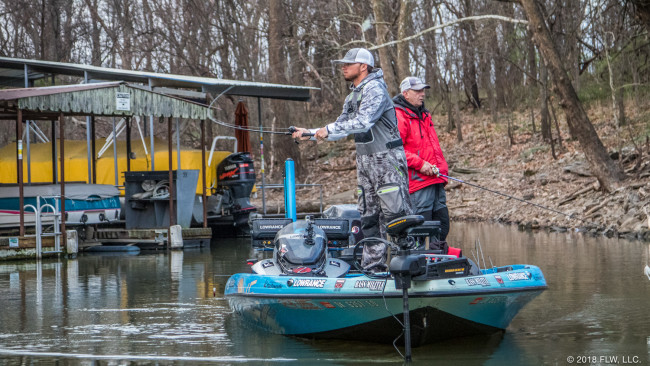
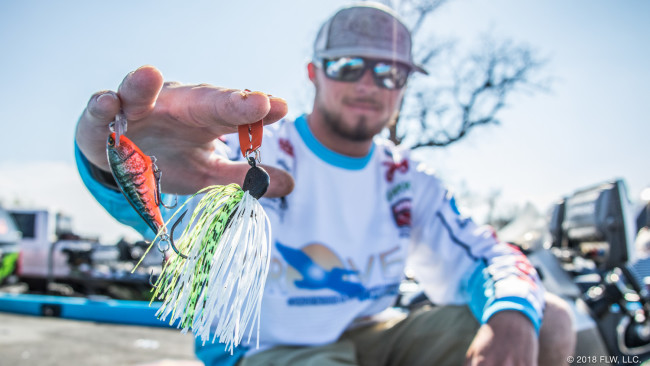
Vibrating jig blades can be colored, too
Three blade colors dominate the vibrating jig market: nickel, black and gold. Nickel and black are probably the most common, and the general consensus is to throw black when using a dark-colored skirt such as green pumpkin or black/blue and nickel when using a bright skirt such as white or white/chartreuse. If you queried every FLW Tour pro, you’d find opinions that differ, of course, but few stray from those most common options.
At the Costa FLW Series event on Grand Lake, top-10 finisher Sheldon Collings, a rookie on the FLW Tour, experimented with a bright orange blade on his JaKKed Baits SKKaterbait with good results. Painters at JaKKed baits custom made the blade at Collings’ request. He paired it with a chartreuse and white skirt.
“I’ve really just started throwing it this year,” Collings says. “I’m really big into throwing painted spinnerbait blades – red and orange – on the Arkansas River and in this region. Fishing on Grand was really tough for me for a while. I thought, ‘I’m throwing a spinnerbait with a painted blade, what about a vibrating jig with a painted blade?’ The first fish I caught on it in practice was a 6 1/2-pounder.”
Collings’ theory on the blade color matches spinnerbait theory: In muddy water, light penetration is reduced, and traditional metallic blades won’t reflect as much light. A solid, brightly colored blade in a gaudy color provides an easy visual target.
Collings fished the bait at a fast clip using a high-speed reel with an 8:1 retrieve ratio for a reactionary presentation that he expanded by mixing in twitches and pauses during the retrieve, often jerking the bait and then killing it near a piece of shallow cover. He says the bait will hunt when twitched, and those extra movements combined with the bright color helped trigger bites.
Also, the color provided that “something different” that tournament anglers so often desire in a situation with a lot of fishing pressure.
“Every angler had a vibrating jig or spinnerbait rigged up, but I highly doubt that any of them had a vibrating jig with a painted blade on it,” Colling says.
The Grove, Okla., pro plans to continue to experiment with painted vibrating jig blades this spring, particularly in low-visibility conditions, but he’s not ready to declare it his standard choice in all scenarios.
“You can probably still catch fish on a painted blade in clear water, but you don’t need it necessarily,” he adds. “I think silver or gold would do a heck of a lot better because it gives that flash off.”
